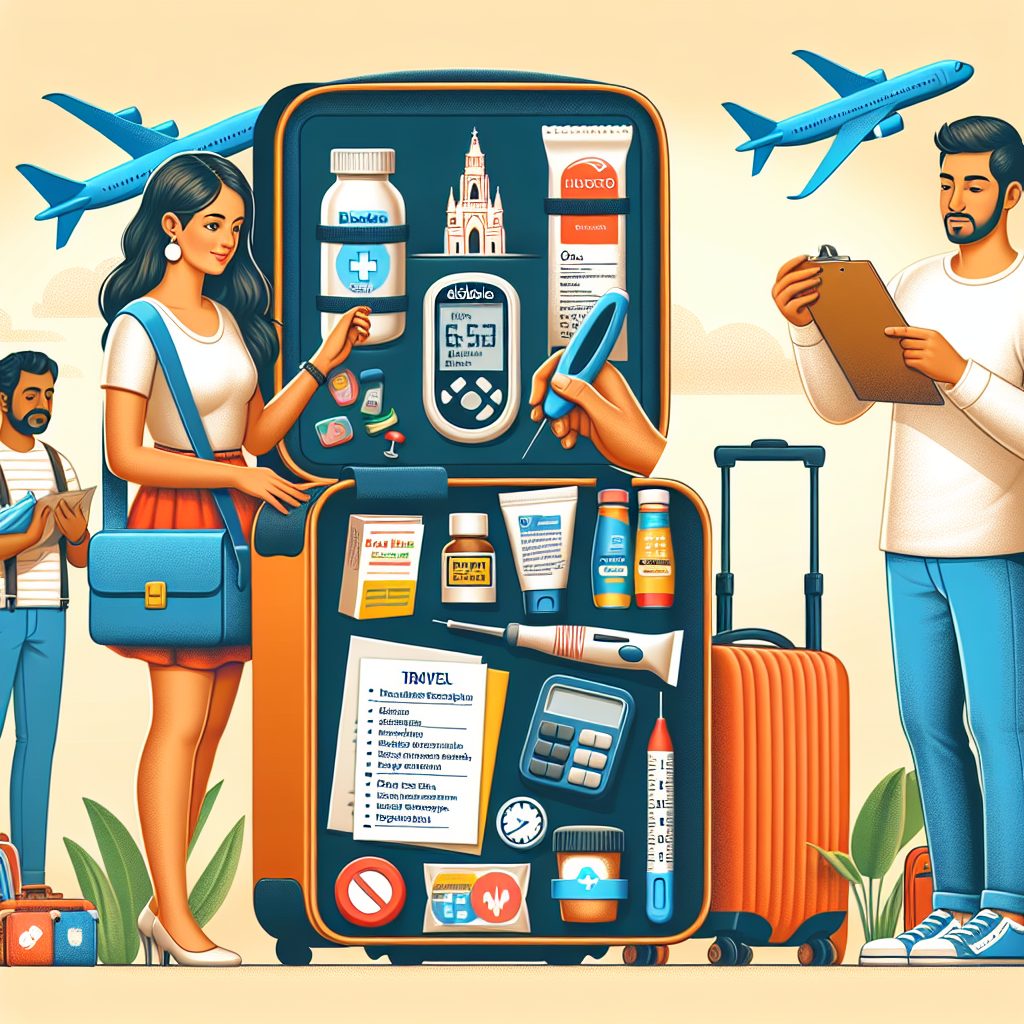Picture this: It’s the beginning of a new year, and you can’t help but feel a sense of excitement building up within you. As a diabetic, you know that traveling requires a bit of extra planning and preparation to ensure a smooth journey. But fear not, because in this article, we’ll guide you on how to effectively plan ahead for your upcoming travel adventures as a diabetic. From packing essential supplies to researching local medical resources, we’ve got you covered. Don’t let diabetes hold you back from exploring the world – with careful planning, you’ll be ready to embark on your next adventure with confidence and peace of mind.

Understanding Your Medical Needs
Identifying specific diabetes care
As a diabetic traveler, it is essential to have a clear understanding of your specific diabetes care needs. This includes knowing your blood sugar levels, any medication you take, and any necessary dietary restrictions. Consult with your healthcare provider before embarking on your trip to ensure you have a comprehensive understanding of your diabetes management plan.
Regular check-ups before traveling
Before you embark on your travel adventure, it is advisable to schedule a comprehensive check-up with your healthcare provider. This will ensure that your diabetes is well-managed and that you are ready for the physical demands of travel. During this appointment, discuss any concerns or questions you may have, and make sure to get any required prescriptions or medical documents for your journey.
Making note of essential medications and doses
To effectively manage your diabetes while traveling, it is crucial to make a note of all essential medications and their respective doses. This will help you stay organized and ensure you have an adequate supply of medication for the duration of your trip. Keep your medications in their original packaging, clearly labeled, and easily accessible. Additionally, consider packing extra supplies in case of unforeseen circumstances or travel delays.
Managing Medication
Organizing a sufficient supply
When it comes to managing your medication while traveling, organization is key. Make sure you have an ample supply of all necessary medications to last the duration of your trip, including any extras for unforeseen circumstances. Consider packing your medications in a designated travel case or pill organizer to keep them secure and easily accessible. It is also a good practice to carry a copy of your prescription and a letter from your healthcare provider verifying your need for the medications.
Storing medication correctly during travel
Proper storage of your medication is crucial to maintain its effectiveness. When traveling, ensure that your medications are stored in a cool and dry place, protected from extreme temperatures and direct sunlight. Avoid placing them in checked luggage, as the temperature and pressure variations in cargo holds can affect their potency. Instead, keep your medications in your carry-on bag, making it easily accessible during your journey.
Understanding foreign medication in case of emergencies
While it is essential to have a sufficient supply of your own medication, it is also important to familiarize yourself with the availability and regulations of foreign medication in your chosen destination. In case of emergencies or unexpected situations, knowing where to access medical assistance and the local diabetes care resources can be invaluable. Research the local healthcare system and contact your embassy or consulate for guidance on accessing medical support if needed.
Creating a Meal Plan
Adapting a meal plan according to destination
Maintaining a balanced meal plan is crucial for diabetics, even while traveling. Before you embark on your journey, take some time to research the local cuisine and identify foods that align with your dietary needs. Make a meal plan that incorporates a variety of fruits, vegetables, lean proteins, and whole grains that are readily available in your destination. If you are unsure about the nutritional content of certain dishes, consult with local restaurants or refer to online resources for guidance.
Maintaining balanced blood sugar levels on the go
Traveling can disrupt your regular eating patterns, making it challenging to maintain balanced blood sugar levels. To mitigate this, try to stick to your regular meal schedule as much as possible. Carry healthy snacks with you, such as nuts or granola bars, to help stabilize your blood sugar throughout the day. Additionally, consider carrying a blood glucose monitor to keep track of your levels and make any necessary adjustments to your meal plan.
Identifying foreign foods that are safe for diabetics
When exploring new destinations, you may come across unfamiliar foods. It is important to identify which foreign foods are safe for diabetics and incorporate them into your meal plan. Opt for dishes that are low in added sugars, fried foods, and excessive carbohydrates. Instead, focus on lean proteins, vegetables, and whole grains. Don’t hesitate to communicate your dietary restrictions or special requirements to local restaurants or accommodations, as they may be able to accommodate your needs.
Stay Hydrated and Avoid Alcohol
Understanding the effects of alcohol on blood sugar levels
Alcohol can significantly affect blood sugar levels, making it important for diabetics to exercise caution when consuming alcoholic beverages. Alcohol can lead to hypoglycemia, especially if consumed on an empty stomach or in excessive amounts. It is crucial to monitor your blood sugar regularly and consume alcohol in moderation, if at all. If you choose to drink alcohol, consider pairing it with a snack or a meal to help regulate your blood sugar levels.
Carrying enough water supply
Staying hydrated is essential for overall health and diabetes management. When traveling, it is important to carry an adequate supply of water to keep you hydrated throughout your journey. Remember to drink water regularly, especially in hot or dry climates or during physical activities. Consider bringing a reusable water bottle to refill and minimize plastic waste. If you are unsure about the quality of tap water in your destination, opt for bottled water or use water purification devices.
Non-alcoholic alternatives in various countries
If you prefer to avoid alcohol altogether, there are various non-alcoholic alternatives available in different countries. Many destinations offer a wide range of non-alcoholic beverages, such as mocktails, fresh fruit juices, herbal teas, and infused waters. These options can be refreshing and enjoyable without negatively impacting your blood sugar levels. Explore local markets and restaurants to discover new and exciting flavors that align with your dietary needs.

Handling Emergencies
Recognizing signs of hypoglycemia and hyperglycemia
As a diabetic traveler, it is crucial to familiarize yourself with the signs and symptoms of hypoglycemia (low blood sugar) and hyperglycemia (high blood sugar). Hypoglycemia symptoms may include dizziness, confusion, sweating, and shaking, while hyperglycemia can manifest as increased thirst, frequent urination, fatigue, and blurred vision. By recognizing these warning signs, you can take prompt action and seek medical assistance if necessary.
Actions to take during a diabetic emergency
In the event of a diabetic emergency, it is essential to remain calm and take appropriate action. If you experience severe symptoms of hypoglycemia or hyperglycemia, administer the necessary treatment as prescribed by your healthcare provider. This may involve consuming a fast-acting source of glucose to raise low blood sugar or adjusting insulin dosages to manage high blood sugar. If your symptoms persist or worsen, seek immediate medical attention.
Availability of medical aid in chosen destination
Before traveling, research the availability of medical aid and diabetes care facilities in your chosen destination. Familiarize yourself with the local emergency services contact number and have it readily accessible. Additionally, consider carrying a medical ID bracelet or card indicating that you have diabetes. Inquire about medical facilities and pharmacies in the area, and keep a list of emergency contacts, including your healthcare provider and travel insurance provider, readily available.
Travel Insurance for Diabetics
Understanding why travel insurance is crucial
Travel insurance is essential for anyone, but particularly important for individuals with pre-existing medical conditions like diabetes. It provides financial protection in case of unexpected events, such as medical emergencies, trip cancellations, or lost luggage. A comprehensive travel insurance policy tailored to your specific needs can provide you with peace of mind, knowing that you are covered in case of any unforeseen circumstances during your travels.
Choosing the right policy
When selecting a travel insurance policy as a diabetic traveler, it is essential to choose one that adequately covers your medical needs. Look for a policy that covers emergency medical expenses, medical evacuation, and trip cancellation or interruption due to health reasons. Read the policy details carefully, paying attention to any exclusions or limitations related to pre-existing conditions. Consider consulting with a travel insurance expert or your healthcare provider for guidance on choosing the right policy for your needs.
Claiming procedures and exemptions
Prior to your trip, familiarize yourself with the claiming procedures and exemptions of your travel insurance policy. Understand the documentation requirements, such as medical certificates or receipts, needed to support your claim. Keep copies of all relevant documents and contact information for your insurance provider easily accessible. In case of an emergency, notify your insurance provider as soon as possible to initiate the claims process and receive guidance on the necessary steps to follow.

Keeping Active While Traveling
Importance of exercising during travel
Regular exercise is crucial for managing diabetes and promoting overall health, even while traveling. Engaging in physical activity can help regulate blood sugar levels, improve insulin sensitivity, and provide mental and emotional well-being. Look for opportunities to incorporate physical activity into your travel itinerary, such as exploring on foot, taking guided hikes, or practicing yoga. Remember to consult with your healthcare provider before engaging in any vigorous activities to ensure they align with your personal health goals.
Keeping track of physical activity
Monitoring your physical activity while traveling can help you understand the impact on your blood sugar levels and make any necessary adjustments to your diabetes management plan. Consider using a fitness tracker or smartphone app to keep track of your steps, distance covered, and calories burned. These tools can provide valuable insights and motivation to stay active and mindful of your physical well-being throughout your travels.
Balancing activity, food, and insulin
Maintaining a delicate balance between physical activity, food intake, and insulin management is essential for diabetic travelers. Be mindful of your meal plan and medication schedule to ensure they align with your activity levels. Plan your meals and snacks accordingly to provide the necessary energy for physical activities without causing blood sugar fluctuations. Regularly monitor your blood sugar levels and make any necessary adjustments to insulin doses under the guidance of your healthcare provider.
Dealing with Travel Stress
Effects of stress on blood sugar levels
Traveling, whether for business or pleasure, can often be accompanied by stress. As a diabetic, it is important to be aware that stress can affect your blood sugar levels. Stress hormones can cause blood sugar to rise, potentially leading to hyperglycemia. Additionally, stress may disrupt sleep patterns, eating routines, and overall diabetes management. Recognize and manage stress effectively to maintain healthy blood sugar levels during your travels.
Techniques for coping with travel-induced stress
To cope with travel-induced stress, it is crucial to prioritize self-care and relaxation techniques. Practice stress management techniques such as deep breathing exercises, meditation, or yoga. Engage in activities that bring you joy and help you unwind, such as reading, listening to music, or spending time in nature. Prioritize sleep and establish a consistent bedtime routine, ensuring you get enough rest to support your physical and emotional well-being.
Importance of sleep and relaxation
Sufficient sleep and relaxation are vital for individuals with diabetes, as they contribute to overall well-being and blood sugar management. Aim for a consistent sleep schedule and create a relaxing pre-sleep routine to ensure quality rest. Take breaks throughout your travels to unwind and recharge, allowing yourself time to relax and destress. By prioritizing sleep and relaxation, you can better manage your diabetes and have a more enjoyable travel experience.

Coping with Time Zone Changes
How time zone changes affect insulin management
Traveling across different time zones can have a significant impact on your insulin management as a diabetic. Time zone changes can disrupt your meal schedule, medication routine, and overall diabetes management plan. To mitigate the effects, work with your healthcare provider to develop a plan for adjusting your insulin doses accordingly. Consider gradually adjusting your insulin doses before your journey or following the new time zone upon arrival to maintain stable blood sugar levels.
Planning insulin doses during long-haul flights
Long-haul flights can present unique challenges for insulin management due to extended periods of sitting and altered meal times. It is essential to plan your insulin doses accordingly to avoid complications. Consult with your healthcare provider to establish a plan for adjusting your insulin doses during your flight. Take into consideration the duration of the flight, any layovers, and potential meal options to ensure you maintain stable blood sugar levels throughout the journey.
Coping with Jet lag
Jet lag can have a significant impact on your overall well-being and diabetes management. To cope with jet lag, gradually adjust your sleep schedule before your trip to align with the destination’s time zone. Upon arrival, allow yourself time to acclimate and adjust to the new schedule. Stay hydrated, maintain a balanced meal plan, and engage in physical activity to support your body’s adjustment to the new time zone. Monitor your blood sugar levels closely and adjust your insulin doses accordingly under the guidance of your healthcare provider.
Travel Vaccinations and Preventive Health Measures
Prioritizing routine vaccinations
Before embarking on your travels, ensure that your routine vaccinations are up to date. Routine vaccinations, such as the influenza vaccine or tetanus booster, are essential for overall health and protection against preventable diseases. Consult with your healthcare provider to review your immunization status and receive any necessary vaccinations before your trip. Remember to carry your vaccination records with you as proof of immunization if required.
Additional vaccinations based on travel destination
Depending on your travel destination, additional vaccinations may be recommended or required to protect against specific diseases prevalent in that region. Research the health risks associated with your chosen destination and consult with a travel health specialist or healthcare provider to determine if any additional vaccinations are necessary. Allow sufficient time for vaccinations to take effect before your trip and carry all relevant documentation with you.
Precautionary measures against infectious diseases
In addition to vaccinations, it is important to take precautionary measures to protect yourself against infectious diseases while traveling. This includes practicing good hand hygiene by washing your hands frequently with soap and water or using hand sanitizers. Avoid close contact with individuals who are sick, and take appropriate measures to protect yourself from insect bites, such as using insect repellents and wearing protective clothing. Stay informed about any local health advisories or alerts and follow guidelines provided by health authorities.
By understanding your medical needs, managing your medication, creating a meal plan, staying hydrated, handling emergencies, obtaining travel insurance, keeping active, dealing with travel stress, coping with time zone changes, and taking preventive health measures, you can have a safe and enjoyable travel experience as a diabetic. Planning ahead and following these guidelines will empower you to take control of your health and make the most of your travels. Remember to consult with your healthcare provider before your journey to ensure a personalized approach to diabetes management while traveling. Happy travels!


